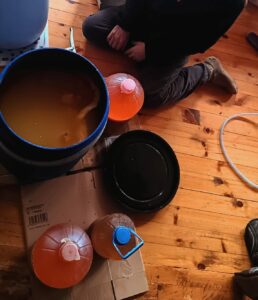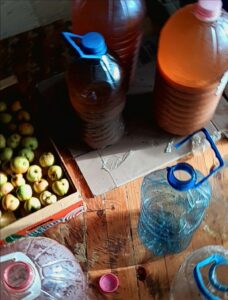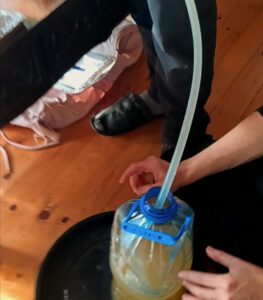Traditional Vinegar Making – A Hands-On Insight with Filip
Recently, we had the privilege of learning the traditional art of vinegar making from our host, Filip. This fascinating process not only gave us insight into how vinegar is made but also into the care and patience that goes into creating this everyday kitchen staple. Our task began with bottling last year’s apple and fig vinegar into 5-liter bottles. There were several important steps involved that are essential for producing high-quality vinegar.
The Importance of Proper Handling
One of the first lessons Filip taught us was how important it is not to shake or move the fermentation barrels. These barrels had been fermenting the vinegar for over a year, and it was crucial not to disturb them. The reason for this is that solid particles and fruit pieces settle at the bottom. When bottling, we only wanted to transfer the clear liquid and not the particles. This ensures that the vinegar remains free from sediment and fruit pieces.
To bottle the vinegar, we used a method similar to siphoning gasoline. A hose was placed into the liquid of the barrel, and by sucking on one end, the clear vinegar was carefully drawn off, leaving the fruit pieces and particles behind. This method required some patience and precision to avoid contamination.
The “Mother of Vinegar” – An Essential Component
After we had bottled the clear vinegar, it was time to transfer the so-called “mother of vinegar” to a separate container. The “mother” is a gelatinous substance that is crucial for future batches of vinegar. It contains acetic acid bacteria, which are necessary to continue the fermentation process. By carefully removing the mother from the previous batch, we can reuse it to start a new batch of vinegar. Our mother is quite old and has been passed down through generations.
Starting a New Batch
For the next batch, we began by cleaning and slicing fresh apples from our own garden. These apple slices were then submerged in a mixture of water and sugar, which helps kickstart the fermentation process. Even without sugar, the vinegar will turn out well, but it is then known as “drinking vinegar” and is less strong. We added the mother from the previous batch to support fermentation and ensure that the new batch would be just as rich and aromatic as the previous one.
The Benefits of Homemade Vinegar
Homemade vinegar, particularly apple cider vinegar, has many benefits that go beyond culinary use. Filip shared several ways that vinegar can also be used in daily life:
- Cleaning: Vinegar is an excellent natural cleaner. It can be used to disinfect surfaces, remove stains, and even clean windows. The acidity of vinegar breaks down grease and dirt, making it an effective and eco-friendly cleaning agent.
- Salads: Vinegar is a key ingredient in many salad dressings. A splash of homemade vinegar, especially apple or fig vinegar, adds a tangy flavor that enhances the taste of simple salads.
- 40-Day Vinegar Cure for Joints and Bones: One of the traditional uses of vinegar is as part of a health regimen. Filip explained that in some cultures, a popular treatment involves consuming vinegar diluted in warm water with honey for 40 days. It is believed that the acetic acid in the vinegar helps better absorb minerals and reduce inflammation in the body.
- Hair and Skin Care: Vinegar can also be used for personal care. As a natural hair rinse, it helps improve shine and reduce dandruff. Additionally, vinegar can be used as a toner to balance the skin’s pH and combat acne.
Conclusion: Experimenting with the Mother of Vinegar
At the end of the project, I plan to take some of the mother with me to experiment. I intend to try different fruits and concentrations to see how the vinegar flavor changes and what new creations I can develop. It will be exciting to further explore the versatile possibilities of vinegar making.
By Sarah K.





